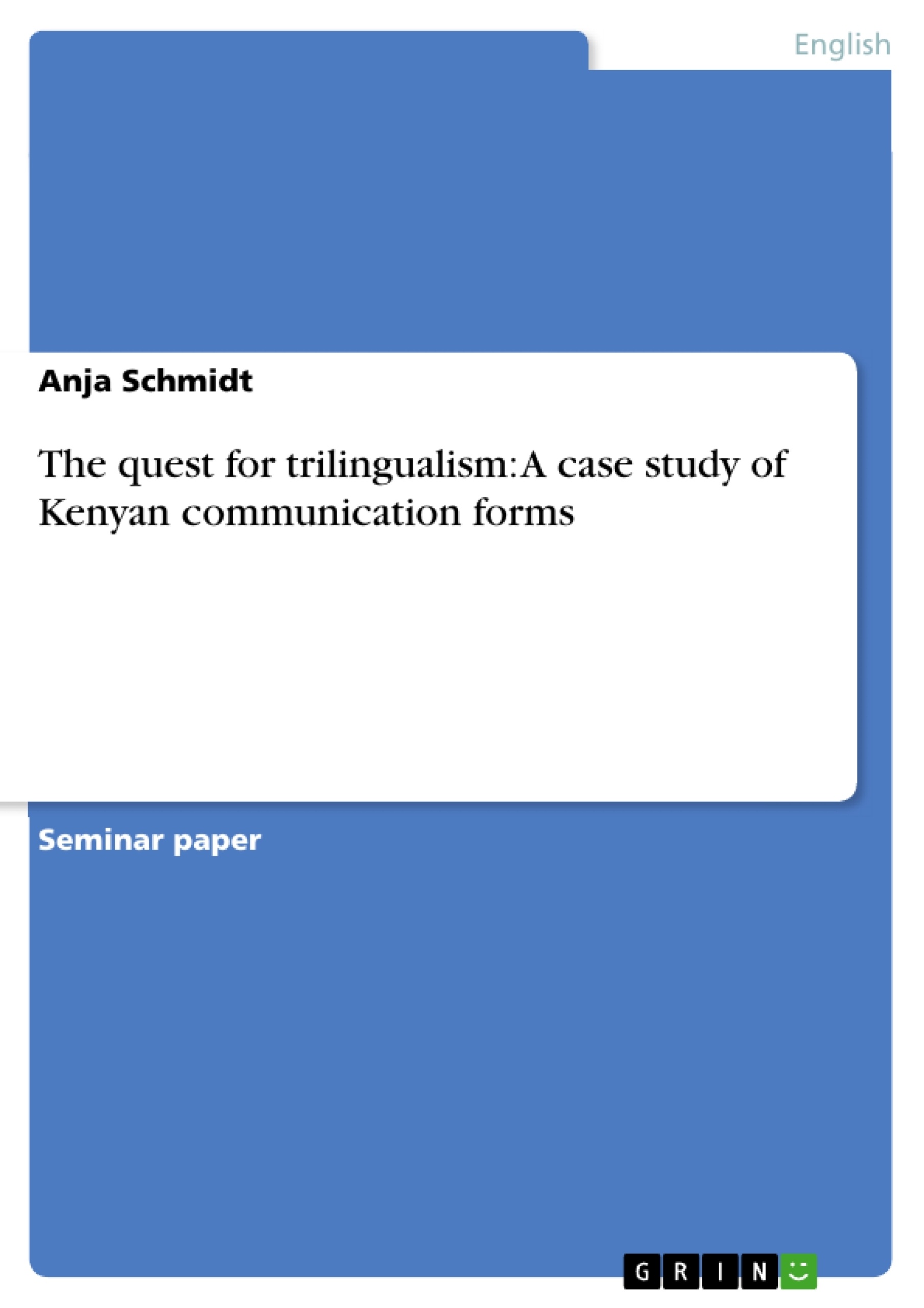When considering the linguistic situation in Kenya, it becomes quite obvious that it is anything but homogenous. Not only the large variety of different ethnic groups, but also British colonial influences have left their marks on this diverse region. With English as the official language and Kiswahili as the national language, it seems that the language situation in Kenya should be clear cut and well defined. Yet, the search for a national identity, feelings of inferiority towards the “colonial” language English and the strive for a better political and economic life in Kenya confront the population with many challenges and problems.
Kenyan society is shaped by 40 to 60 African ethnic languages, such as Maasai or Dholuo. The main means of communication among these different ethnic groups has become Kiswahili. But Kiswahili itself has seven dialects and several sub-dialects. In addition, several European languages were left behind by the colonial era and Arabic and Asian merchants have brought their languages with them too. Thus, the language situation in Kenya is extremely complex and considered to be a 3 + 1 language country. That means that most Kenyan citizens speak three languages (plus or minus one): the mother tongue (in most cases an African ethnic language), Kiswahili – the national language and most often also lingua franca, and English – the official language and therefore used for all educational and governmental purposes.
But the competence and use of these communication systems varies largely. Like citizens of other imposed multilingual environment situations, Kenyans have developed their very own way to communicate with each other. But language is not only a pure means of communication – it carries different identities depending on social context. It serves to distinguish oneself from others as well as to express one’s membership to a certain group and thus influencing one’s understanding of culture.
However, my aim in this paper is to analyse the current trilingualism in Kenya and explain the different levels of competence. I will put the main emphasis on English and Kiswahili, as they receive official recognition by the Kenyan government. When considering the interaction of the official languages and those inferior to them, I will also refer to some new language forms that might influence the Kenyan society considerably in the future.
Table of Contents
- Introduction
- Development of a multilingual Kenyan community
- Influences of the colonial era
- Language policy after independency
- The rise of Kiswahili as lingua franca
- World integration factors
- The Kenyan system of trilingualism
- English
- Kiswahili
- Ethnic languages
- Other means of communication
- The use of different communicative patterns
- Preferences
- Competence and Connotation
- Interaction: Sheng and Engsh
- Consequences
- The question of identity
- Individual language patterns
Objectives and Key Themes
This paper aims to analyze the current trilingualism in Kenya and explain the different levels of competence in English and Kiswahili, the two languages officially recognized by the Kenyan government. The paper explores the historical and current linguistic environment in Kenya, considering the interaction of official languages with those of lesser status.
- The impact of the colonial era on Kenyan language policy and the development of a multilingual society
- The emergence of Kiswahili as the lingua franca and its role in Kenyan society
- The dynamics of trilingualism in Kenya, with particular attention to the official languages, English and Kiswahili
- The influence of language on identity, cultural expression, and social interactions
- The rise of new language forms, such as Sheng and Engsh, and their potential impact on the Kenyan linguistic landscape
Chapter Summaries
- Introduction: This chapter introduces the diverse and complex language situation in Kenya, highlighting the influence of colonial influences, the variety of ethnic languages, and the roles of English and Kiswahili. It sets the context for the study of trilingualism in Kenya.
- Development of a multilingual Kenyan community: This chapter explores the historical factors that have shaped the multilingual nature of Kenyan society. It examines the influence of the colonial era, the role of Christian missionaries, and the emergence of Kiswahili as the lingua franca.
- The Kenyan system of trilingualism: This chapter outlines the three main languages used in Kenya: English, Kiswahili, and ethnic languages. It discusses the official status of English and Kiswahili, the prevalence of ethnic languages, and the use of other means of communication.
- The use of different communicative patterns: This chapter examines the different ways in which Kenyans use language in their daily lives. It discusses preferences for specific languages in different contexts, the connection between language and identity, and the emergence of new hybrid languages like Sheng and Engsh.
- Consequences: This chapter discusses the implications of trilingualism in Kenya, including the question of national identity and the impact of language on individual language patterns.
Keywords
Key concepts explored in this paper include: trilingualism, Kenya, language policy, colonial influences, Kiswahili, lingua franca, English, ethnic languages, identity, communication, Sheng, Engsh, linguistic diversity.
- Citar trabajo
- Anja Schmidt (Autor), 2003, The quest for trilingualism: A case study of Kenyan communication forms, Múnich, GRIN Verlag, https://www.grin.com/document/17321



